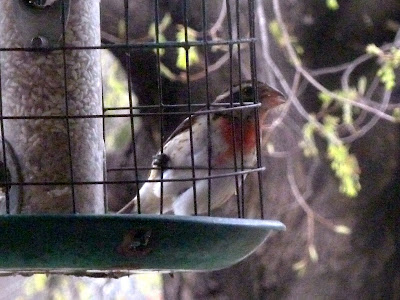A wish came true this week, as twice we have seen a pileated woodpecker at the suet log that hangs from the maple tree in front of our house -- and today I was able to grab my camera and capture the moment. The first time, last Sunday, I posted on Facebook about the impact of the sighting: "Freaking amazing - first-ever sighting of a pileated woodpecker at our house a few minutes ago, feeding from a log-style suet feeder. Our jaws were down around our knees."
This is a huge woodpecker, nearly the size of a crow. I've only seen a pileated a handful of times before, and until now not anywhere near this close. When seen in flight from below, it shows large areas of white bordered with black. In February I wrote about one I'd seen flying in our neighborhood, and included someone else's terrific YouTube video that shows the striking black and white wings in flight.
For size contrast, see below on this same suet log a red-bellied woodpecker, which at roughly the size of an American robin is a good-sized bird in its own right. At 9 inches in length compared to the pileated's 15.7 to 19.3 inches, it is only about half the length of the pileated and weighs only a quarter as much.
By the way, pileated can be pronounced either with a long or short initial I: py-lee-ated or pill-ee-ated, though the long-I pronunciation is listed first in both the Merriam-Webster Dictionary and the American Heritage Dictionary. The word essentially means with a crest, or cap.
We are thrilled that we now seem to be familiar territory for this impressive bird and that we can add the pileated woodpecker to our "yard bird" list.























